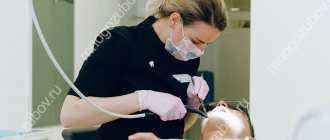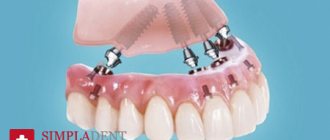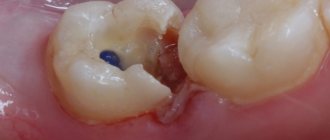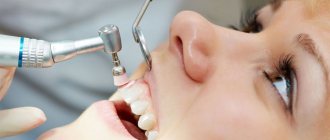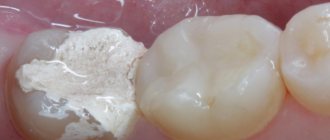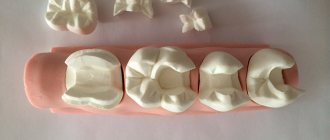Indications and contraindications for removal
The removal operation leads to complete loss of the crown and deformation of the jaw, so dentists recommend installing a prosthesis to avoid complications and cosmetic defects.
The decision on removal is made by the dentist after examination and x-ray examination on an individual basis. The following conditions are indications for urgent surgery:
- acute inflammatory process, tissue suppuration and swelling, spread of infection to soft tissues and bones;
- abscess, cyst suppuration;
- severe swelling and the impossibility of therapeutic treatment;
- tooth decay and impossibility of restoration.
Extirpation is prescribed routinely for the following pathologies:
- Chronic periodontitis. Advanced sluggish inflammation of connective tissue.
- Advanced periodontitis. Inflammation of the gums causes teeth to become loose and fall out.
- Malocclusion associated with abnormal positioning of incisors and molars. In this case, the operation is performed to restore the correct structure of the dentition.
- Fracture of the jaw along with the tooth.
- With the development of neoplasms in the jaw area, especially malignant ones.
You cannot perform surgery during an exacerbation of respiratory diseases or stomatitis, since the postoperative socket is highly likely to become infected and fester.
A contraindication to extirpation is the serious condition of the patient - the development of renal failure, cancer, acute circulatory and cardiac disorders, etc. In this case, it is recommended to stop the underlying disease, and only then proceed with dental surgery.
The relative indication for surgery is the first trimester of pregnancy, since anesthesia cannot be used. Surgery is not recommended for the 9th month of gestation, as well as for women during menstruation, since the woman’s body undergoes a heavy load during this period.
Who will have to part with a tooth?
Complications following tooth extraction in the doctor's office are extremely rare. Much more often, sad consequences occur when it spontaneously falls out due to destruction or injury. In such cases, there are two options: restoration of dentin and enamel or removal of the tooth root.
The tooth root will have to be removed if the following symptoms occur:
- constant discomfort in the gums;
- sharp pain when chewing;
- swollen soft tissue;
- bleeding;
- the appearance of pus.
A sure sign of an inflammatory process in the gums is an increase in body temperature in the absence of symptoms of another disease.
Important! You cannot postpone a visit to the dentist, even if only one of these symptoms appears. Any suspicion that the tooth root remains in the gum and has begun to rot should prompt an urgent visit to a doctor.
What are the roots of teeth, look at the photo:
Temporary contraindications
Surgical removal of the root of a decayed tooth is contraindicated during:
- relapse of complex mental disorder;
- acute phase of ARVI;
- exacerbation of neurological disease;
- rehabilitation after a heart attack.
Doctors at dental clinics are aware of all contraindications to extraction. But not all conditions have clear clinical signs, so in order to avoid unpleasant consequences, it is necessary to warn the doctor about the ailment.
Is it painful to remove without pain relief?
Treatment without anesthesia is carried out quite often at the request of the patient. Treatment of shallow caries and extraction of baby teeth are almost painless. In such cases, anesthesia may not be used, or only a local anesthetic may be used.
Removal is definitely a painful procedure. How severe the pain will be depends on the condition of the crown and root, and its location. Very excruciating pain awaits a patient who is indicated for the removal of a wisdom tooth and entire, firmly seated molars.
Modern dentistry allows the use of anesthesia even in cases of intolerance to certain drugs. It is recommended to tell the doctor which medications cause negative reactions, and the dentist will select a safe remedy.
Types of anesthetics
Removal of a molar tooth with an injection involves several types of pain relief; the choice is made by the doctor, depending on the location of the molar, the degree of tissue destruction, the expected time of extraction and other factors:
- Applique. This type of anesthesia is used mainly if the patient is afraid of pain from the injection of an injectable anesthetic, as well as when tartar or baby teeth are removed from a child. A special gel or spray is applied to the gum area near the molar.
- Infiltration. This type of anesthesia involves two injections of a substance, from the side of the palate and the lip, the medicine is injected into the apex of the root through the gum. Freezing begins within two minutes after the injections and lasts for another hour after the end of the extraction procedure. Infiltration anesthesia is good because the patient does not feel pain, and there is no numbness in most of the face.
- Conductor. Such anesthesia is necessary when removing wisdom teeth and molars. An injection is made in the area of the trigeminal nerve, as a result of which the sensitivity of a large part of the face is blocked, and numbness persists after extraction for another 1.5–2 hours.
- Intraligamentary. The patient receives an injection into the periodontal fissure, it is carried out under more powerful pressure. The medicinal substance is located inside the bone tissue of the alveolar process, due to which the effect occurs instantly, but lasts about 30 minutes.
- Stem. This type of anesthesia involves serious maxillary surgical interventions; the branches of the maxillary and mandibular nerves are blocked. The injection is injected into the lower edge of the cheekbone, a pronounced freezing effect begins after 10 minutes.
- Sedation. With this type of anesthesia, the patient is depressed or asleep (with deep sedation). The superficial type of such anesthesia allows a person to respond to the doctor’s voice and follow his commands, swallow saliva, open his mouth, while the patient is relaxed and does not feel any discomfort. The medicine is administered through a mask or injected into a vein.
In especially severe cases, when extensive surgery is required, the patient is allergic to other types of anesthesia, or is simply panicky about the extraction procedure, doctors use general anesthesia. However, this method is used extremely rarely, since general anesthesia requires intervention in a hospital setting and under the strict supervision of an anesthesiologist.
At the same time, the medicine remains sterile, it does not need to be opened, and it does not come into contact with air when drawn into a syringe. The thinnest needle ensures minimal discomfort when administering the drug. The following modern anesthetics are used for extraction:
- Articaine is an anesthetic drug that is used in conduction and infiltration anesthesia, when it is necessary to remove several molars in a row;
- Scandonest is a drug contraindicated in adolescents under 15 years of age and elderly patients, as well as people with diabetes, kidney, liver and heart diseases;
- Septanset is a medicine that contains an anesthetic and adrenaline, it is used for the removal of molars, long-term treatment and when cleaning the roots of teeth.
Modern drugs rarely cause allergies, but if a person has a predisposition, he should definitely notify the dentist about this in order to avoid unforeseen situations.
Tooth extraction with anesthesia injection
Dentists recommend carrying out the procedure with an injection of anesthesia, then the question is, does it hurt?
remove the tooth, it will fall off on its own. The drug reduces the conductivity of nerve endings, and pain impulses are temporarily not transmitted, the patient does not feel anything. The effectiveness of anesthesia depends on the drug. If a weak remedy is used, the patient feels mild pain.
The anesthesia lasts for a limited amount of time. The drug is gradually absorbed and eliminated from the body, and the sensitivity of the nerve endings is completely restored.
Anesthesia injections are performed differently in the upper and lower jaws due to the difference in structure. Less medication is required to treat the upper jaw because it has a porous structure. The medicine easily penetrates the tissue and acts quickly. When treating the lower jaw, it is necessary to inject the drug deeply. There are strong muscles and tight ligaments that interfere with the distribution of anesthesia.
Anesthesia methods
There are three methods of anesthesia:
- local using a spray;
- local injection into the gum;
- general anesthesia or anesthesia.
Local is used if the patient can remain motionless during manipulation. General anesthesia is indicated for people with severe mental illness, children, and sometimes adults who have a strong fear of the dentist.
Most patients are recommended to have local anesthesia injected into the gums around the affected area. If the patient is afraid of surgery, it is recommended that he take a sedative first. It is important to note that alcohol is contraindicated before removal.
Local anesthesia with a spray is carried out in cases where the tooth is loose, or for therapeutic purposes. Dental spray is often used to remove baby teeth in young children.
What drugs are used for pain relief
Just a few decades ago, the only painkiller used by dentists was novocaine. Despite its low toxicity, it very often caused serious complications in patients: from an allergic reaction to anaphylactic shock.
The next step was the use of lidocaine. It is still used to this day in budget dental offices, and has an undeniable advantage: allergies to the drug occur extremely rarely. The problem is different: to prolong the effect of lidocaine, the dentist has to add a drop of adrenaline to it. Moreover, this is done “by eye”. And as soon as the doctor’s hand trembles a little, the patient is guaranteed such unpleasant symptoms as rapid heartbeat and dizziness.
It is much more comfortable for both the doctor and the patient of the dental clinic to deal with articaine anesthetics. These include:
- ubistezin
; - ultracaine;
- septanest
.
Firstly, such drugs are administered with a carpule syringe, which ensures that the injection itself is less painful. Secondly, the ratio of adrenaline and anesthetic in the drugs is adjusted to the nearest milliliter. This means that wisdom tooth removal will be painless, and the patient will not experience any side effects.
Important! If the patient is at risk, it is recommended to use an anesthetic that does not contain adrenaline.
How does deletion work?
Removal surgery can be simple or complex. The doctor grabs the crown with forceps and swings it from side to side, spinning it around its axis to free it from ligaments and bone tissue. As a result, the surgeon removes the crown along with the root and places a gauze tampon in the hole to stop the bleeding.
If the crown has collapsed almost completely and there is no way to grab it with forceps and remove it along with the root, the operation is considered difficult. If the root is not affected, it can be left and a prosthesis installed on top. The damaged root is removed by cutting the gum. This operation is more traumatic and painful for the patient.
After surgery, it is recommended to stop drinking and eating for 2-3 hours, and then not chew on the injured side for several days. A blood clot forms in the hole, which protects the wound from infection, so you should not touch the gum with your tongue and try to rinse out the clot.
After the procedure, the gums hurt for another 1-3 days, depending on the degree of injury. Painkillers are prescribed to relieve pain. If the unpleasant sensations do not go away within 2-3 days, but only intensify, you should urgently consult a doctor.
Recommendations after removal
Regardless of the method by which the tooth was removed, in the first 2 days the patient must observe a special diet, activity and hygiene. This is necessary to preserve the blood clot in the wound, which helps maintain the sterility of bone tissue and promotes its regeneration.
In the first 48 hours after removal you cannot:
|
Failure to comply with these recommendations most often causes the clot to fall out of the socket and the development of alveolitis or bleeding.
After tooth extraction it is recommended:
- make oral baths from chamomile and sage decoctions (the decoction prepared according to the instructions is taken into the mouth and held there for 10 minutes, without rinsing or moving the tongue) 2-3 times a day;
- take non-steroidal anti-inflammatory drugs (especially after atypical removal, when the tissue is severely damaged and swelling occurs) - nimesulide, diclofenac sodium, ibuprofen, paracetamol, etc. (it is important that the medicine does not reduce blood clotting).
Sometimes patients need preliminary preparation for removal. People taking aspirin and other medications that impair blood clotting should stop taking them a week before the procedure. For those who suffer from increased excitability and anxiety, you can start taking valerian or motherwort 1-2 weeks before removal, having previously agreed with your dentist and your therapist.
Even if the removal was painless and quick, you should not ignore the doctor’s advice. The right approach to rehabilitation will help you avoid complications and recover faster.
Molar tooth extraction
It is recommended to begin removing molars or molars after examining an x-ray, since the doctor needs to assess the location of the roots. A blind operation is fraught with complications.
If the molar has no abnormalities, it is removed with forceps. For maxillary molars, bayonet forceps are used. To remove teeth from the lower jaw, forceps with spikes are used that reach under the gum.
If the molar has a structural anomaly, for example, the root is located deeper than usual or the presence of bone tissue in the wrong place, then the situation becomes more complicated. A complex operation is performed with dissection of the gums or jaw tissue. If you try to remove such a molar in the usual way, nothing will work. Part of the tooth root may remain inside, increasing the risk of infection.
Wisdom tooth removal
Removing an upper wisdom tooth is no different from a similar operation on a regular molar and is carried out in the following order:
- anesthesia is performed;
- the doctor separates the tooth from the gum;
- the doctor grabs the tooth with forceps;
- shaking it from side to side, removes it.
The lower ones have tortuous roots; they are difficult to remove; the crown will need to be divided into parts. Sometimes wisdom teeth do not grow in completely; they are called impacted. Often this situation is accompanied by inflammation and suppuration of the gums, the patient complains of pain and the doctor decides to remove it. The impacted tooth is removed after making an incision in the gum, freeing the crown.
Is it painful to remove the nerve of a tooth?
The question of the pain of the process of removing the nerve of a tooth interests many people: most patients think that treating teeth is very painful and this fear is the reason that treatment of caries and pulpitis is postponed until the moment when the tooth can no longer be saved. The fear of dentists is reinforced by reviews on the Internet, in which people describe that their tooth extraction was accompanied by severe pain. But if you start to understand these reviews, you can find out the following important details:
- A person complaining of pain when the nerve of a tooth was removed applied to a state clinic for treatment under the policy. Here we can give the following comment: unfortunately, budget dentistry in our country does not have the required level of equipment, they often use outdated materials and anesthetics;
- The man chose an inexperienced and unqualified doctor to treat his teeth. The anesthetic and its dose are selected individually for each patient, based on the characteristics of the clinical case. If the doctor is incompetent, he may incorrectly calculate the dose of the anesthetic drug and give the injection incorrectly.
If you choose good dentistry to remove a nerve in a tooth, with competent specialists, equipped with all the necessary equipment, tools, advanced drugs and materials, you are guaranteed to receive a high-quality dental treatment service that will take place without pain and discomfort.
In our dental clinic “Firadent”, tooth nerve removal is carried out using highly effective anesthetic drugs, and for patients who are afraid of dentists to the point of panic, we can offer dental treatment and nerve removal under sedation.
YOU NEED TO REMEMBER! Sedation should not be confused with general anesthesia. Sedation is a light medicinal sleep, the use of which in dental treatment has a minimum of contraindications and is not accompanied by severe side effects. During dental treatment under sedation, you will sleep peacefully, and the doctor will perform all the necessary actions. You can read more about sedation or dental treatment during sleep on the website of our dentistry in Moscow - “Firadent”.
Is it painful to remove the root?
If the patient does not treat caries for a long time, the crown will completely crumble, but the root will remain inside the gum. This condition is fraught with the development of inflammation and suppuration, so it is recommended to cure the root and install a prosthesis, or remove the root if it cannot be treated.
Removing the root does not hurt if anesthesia is used. But after the operation, when the effect of the drug wears off, aching pain will appear. Its severity depends on the degree of injury to the gums. Unpleasant sensations occur 3 days after surgery.
Tooth extraction during pregnancy
Dentists recommend checking the teeth of a woman who is planning a pregnancy so that treatment can be carried out in advance. If the patient neglects the recommendation and is faced with the need for removal, the procedure is performed in the second trimester. Starting from the 12th week of pregnancy, you can use some anesthetics, but there is still a risk of complications.
Surgery is stressful for the body, especially for women during gestation. The procedure can lead to premature birth, cause high blood pressure, dizziness and fainting. Therefore, dentists recommend avoiding removal in pregnant women and, if possible, carrying out therapeutic treatment.
Removing a nerve in a tooth: the consequences of poor-quality treatment
Removing the nerve of a tooth is a complex medical procedure that requires the doctor to have knowledge, experience, and attentiveness during the manipulations. If the dentist makes inaccuracies and mistakes when removing the nerve of a tooth, all this can lead to the development of complications in which it will be impossible to save the tooth.
For example, if, when removing a nerve, part of the instrument breaks off and remains in the dental canal, the tooth cannot be cured in the future and will need to be removed. And the process of removing a broken instrument from a dental canal will be difficult.
After poor-quality removal of a nerve, the tooth may become ill after some time under an already installed permanent filling. The appearance of this complication is explained by the fact that when working with the tooth canals, the doctor did not completely remove damaged and infected tissue from them. If, after removing the nerve of a tooth, the tooth begins to hurt, you should immediately contact the dentist, because the pain syndrome in this case can be a symptom of periodontitis, an inflammatory process that affects the root of the tooth. If periodontitis destroys the root system, it will be impossible to save the tooth; it will have to be removed.
No less important is the use of high-quality filling materials, which are used to restore the natural crown of the tooth after nerve removal. If you choose an inexpensive material, the tooth may subsequently become gray or yellow, and this unpleasant consequence will be impossible to eliminate with regular whitening.
We hope you now understand why it is so important to carefully choose a clinic and a dentist to remove a nerve from a tooth and treat teeth in general. When choosing a clinic, you need to pay attention not to prices and promotions, but to the level of its equipment, and also find out in advance all possible information on the level of qualifications of the dentists working in it.
At the Firadent clinic, the procedure for nerve removal and tooth canal treatment is carried out using a dental microscope - a modern optical device with a powerful magnifying effect. By accurately seeing the area of work and all the tissues of the tooth, the dentist will remove the nerve and affected tissues accurately, without affecting healthy tissues.
YOU NEED TO REMEMBER! If, after removing the nerve, you are bothered by mild pain for several days, then it cannot be attributed to complications and signs of poor-quality treatment. Removal of a nerve involves intervention in the internal structure of the tooth, and therefore pain for some time after this operation is recognized by dentists as a norm that does not require special treatment. In this case, you can eliminate discomfort by taking pharmaceutical painkillers and rinsing.
But if more than a week has passed after removing the nerve of the tooth, and the pain does not go away and, moreover, its intensity is increasing, and the gums in the area of the treated tooth are swollen, you need to urgently contact the dentist who performed your treatment.
Sources
- Operative maxillofacial surgery and dentistry. Ed. V.A. Kozlova, I.I. Kagan. Year 2022.
- Delete operation. Tutorial. Author Bazikyan E.A. and others. Dentistry. Chapter 4. Afanasyev V.V. [and etc.]; Ed. V. V. Afanasyeva. Year 2018
- Dentistry. Chapter 4. Afanasyev V.V. [and etc.]; Ed. V. V. Afanasyeva. Year 2018
- Propaedeutic dentistry. Edited by E.A. Bazikyan, chapter 12.
- Biomechanics of removal surgery. St. Petersburg State Medical University named after I. P. Pavlova, Dept. surgical dentistry, Dept. medical and biological physics; [comp. Lisenkov V.V. et al.]
Attention!
This article is posted for informational purposes only and under no circumstances constitutes scientific material or medical advice and should not serve as a substitute for an in-person consultation with a professional physician.
For diagnostics, diagnosis and treatment, contact qualified doctors! Number of reads: 6085 Date of publication: 03/11/2019
Dentists - search service and appointment with dentists in Moscow

